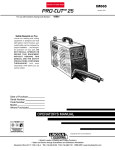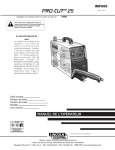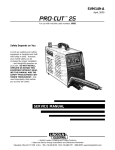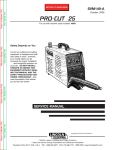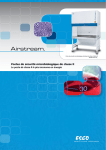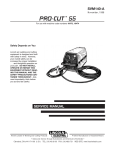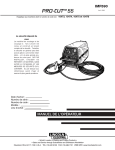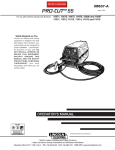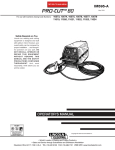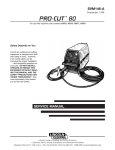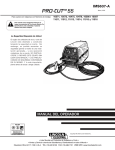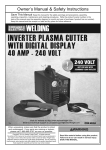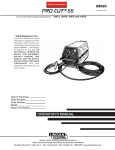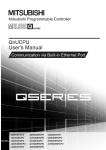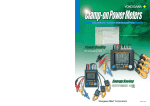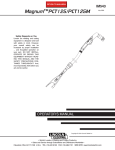Download Lincoln Electric IM665 User's Manual
Transcript
RETURN TO MAIN MENU IM665 PRO-CUTTM 25 For use with machines having Code Number: September, 2004 10661 Safety Depends on You Lincoln arc welding and cutting equipment is designed and built with safety in mind. However, your overall safety can be increased by proper installation ... and thoughtful operation on your part. DO NOT INSTALL, OPERATE OR REPAIR THIS EQUIPMENT WITHOUT READING THIS MANUAL AND THE SAFETY PRECAUTIONS CONTAINED THROUGHOUT. And, most importantly, think before you act and be careful. OPERATOR’S MANUAL Copyright © 2004 Lincoln Global Inc. • World's Leader in Welding and Cutting Products • • Sales and Service through Subsidiaries and Distributors Worldwide • Cleveland, Ohio 44117-1199 U.S.A. TEL: 216.481.8100 FAX: 216.486.1751 WEB SITE: www.lincolnelectric.com i i SAFETY WARNING PLASMA CUTTING or GOUGING can be hazardous. PROTECT YOURSELF AND OTHERS FROM POSSIBLE SERIOUS INJURY OR DEATH. KEEP CHILDREN AWAY. PACEMAKER WEARERS SHOULD CONSULT WITH THEIR DOCTOR BEFORE OPERATING. Read and understand the following safety highlights. For additional safety information it is strongly recommended that you purchase a copy of “Safety in Welding & Cutting - ANSI Standard Z49.1” from the American Welding Society, P.O. Box 351040, Miami, Florida 33135 or CSA Standard W117.2. BE SURE THAT ALL INSTALLATION, OPERATION, MAINTENANCE, AND REPAIR PROCEDURES ARE PERFORMED ONLY BY QUALIFIED INDIVIDUALS. ELECTRIC SHOCK can kill. 1.a. The electrode and work (or ground) circuits are electrically “hot” when the power source is on. Do not touch these “hot” parts with your bare skin or wet clothing. Wear dry, hole-free gloves to insulate hands. 1.b. When the power source is operating voltages in excess of 250 volts are produced. This creates the potential for serious electrical shock - potentially even fatal. 1.c. Insulate yourself from work and ground using dry insulation. When cutting or gouging in damp locations, on metal framework such as floors, gratings or scaffolds and when in positions such as sitting or lying, make certain the insulation is large enough to cover your full area of physical contact with work and ground. 1.d. Always be sure the work cable makes a good electrical connection with the metal being cut or gouged. The connection should be as close as possible to the area being cut or gouged. 1.e. Ground the work or metal to be cut or gouged to a good electrical (earth) ground. 1.f. Maintain the plasma torch, cable and work clamp in good, safe operating condition. Replace damaged insulation. FUMES AND GASES can be dangerous. 3.a. Plasma cutting or gouging may produce fumes and gases hazardous to health. Avoid breathing these fumes and gases.When cutting or gouging, keep your head out of the fumes. Use enough ventilation and/or exhaust at the arc to keep fumes and gases away from the breathing zone. When cutting or gouging on lead or cadmium plated steel and other metals or coatings which produce highly toxic fumes keep exposure as low as possible and below Threshold Limit Values (TLV) using local exhaust or mechanical ventilation. In confined spaces or in some circumstances, outdoors, a respirator may be required. Additional precautions are also required when welding on galvanized steel. 3.b. Do not use plasma arc cutting or gouging in locations near chlorinated hydrocarbon vapors coming from degreasing, cleaning or spraying operations. The heat and rays of the arc can react with solvent vapors to form phosgene, a highly toxic gas, and other irritating products. 3.c. Gases used for plasma cutting and gouging can displace air and cause injury or death. Always use enough ventilation, especially in confined areas, to insure breathing air is safe. 3.d. Read and understand the manufacturer’s instructions for this equipment and the consumables to be used, including the material safety data sheet (MSDS) and follow your employer’s safety practices. 1.g. Never dip the torch in water for cooling or plasma cut or gouge in or under water. 1.h. When working above floor level, protect yourself from a fall should you get a shock. 1.i. Operate the pilot arc with caution. The pilot arc is capable of burning the operator, others or even piercing safety clothing. 1.j. Also see Items 4c and 6. ARC RAYS can burn. 2.a. Use safety glasses and a shield with the proper filter and cover plates to protect your eyes from sparks and the rays of the arc when performing or observing plasma arc cutting or gouging. Glasses,headshield and filter lens should conform to ANSI Z87. I standards. 2.b. Use suitable clothing including gloves made from durable flame-resistant material to protect your skin and that of your helpers from the arc rays. 2.c. Protect other nearby personnel with suitable non-flammable screening and/or warn them not to watch the arc nor expose themselves to the arc rays or to hot spatter or metal. CUTTING SPARKS can cause fire or explosion. 4.a..Remove fire hazards from the plasma cutting or gouging area. If this is not possible, cover them to prevent the cutting or gouging sparks from starting a fire. Remember that welding sparks and hot materials from plasma cutting or gouging can easily go through small cracks and openings to adjacent areas. Avoid cutting or gouging near hydraulic lines. Have a fire extinguisher readily available. 4.b. Where compressed gases are to be used at the job site, special precautions should be used to prevent hazardous situations. Refer to “Safety in Welding and Cutting” (ANSI Standard Z49.1) and the operating information for the equipment being used. 4.c. When not cutting or gouging, make certain no part of the electrode circuit is touching the work or ground. Accidental contact can cause overheating and create a fire hazard. 4.d. Do not cut or gouge tanks, drums or containers until the proper steps have been taken to insure that such procedures will not cause flammable or toxic vapors from substances inside. They can cause an explosion even though they have been “cleaned.” For information purchase “Recommended Safe Practices for the Preparation for Welding and Cutting of Containers and Piping That Have Held Hazardous Substances”, AWS F4.1 from the American Welding Society (see address above). 4.e. Vent hollow castings or containers before heating, cutting or gouging. They may explode. 4.f. Do nor fuel engine driven equipment near area where plasma cutting or gouging. Apr. ‘93 ii ii SAFETY 4.g. Sparks and spatter are thrown from the plasma arc. Wear safety glasses, ear protection and oil free protective garments such as leather gloves, heavy shirt, cuffless trousers, high shoes and a cap over your hair. Wear ear plugs when cutting or gouging out of position or in confined places. Always wear safety glasses with side shields when in a cutting or gouging area. 4.h. Connect the work cable to the work as close to the cutting or gouging area as practical. Work cables connected to the building framework or other locations away from the cutting or gouging area increase the possibility of the current passing through lifting chains, crane cables or other alternate circuits. This can create fire hazards or overheat lifting chains or cables until they fail. PLASMA ARC can injure. 7.a. Keep your body away from nozzle and plasma arc. 7.b. Operate the pilot arc with caution. The pilot arc is capable of burning the operator, others or even piercing safety clothing. CYLINDER may explode if damaged. 5.a. Use only compressed gas cylinders containing the correct gas for the process used and properly operating regulators designed for the gas and pressure used. All hoses, fittings, etc. should be suitable for the application and maintained in good condition. ELECTRIC AND MAGNETIC FIELDS may be dangerous 5.b. Always keep cylinders in an upright position securely chained to an undercarriage or fixed support. 5.c. Cylinders should be located: • Away from areas where they may be struck or subjected to physical damage. • A safe distance from plasma cutting or gouging, arc welding operations and any other source of heat, sparks, or flame. 5.d. Never allow any part of the electrode, torch or any other electrically “hot” parts to touch a cylinder. 5.e. Keep your head and face away from the cylinder valve outlet when opening the cylinder valve. 5.f. Valve protection caps should always be in place and hand tight except when the cylinder is in use or connected for use. 5.g. Read and follow the instructions on compressed gas cylinders, associated equipment, and CGA publication P-l, “Precautions for Safe Handling of Compressed Gases in Cylinders,”available from the Compressed Gas Association 1235 Jefferson Davis Highway, Arlington, VA 22202. FOR ELECTRICALLY powered equipment. 6.a. Turn off input power using the disconnect switch at the fuse box before working on the equipment. 8.a. Electric current flowing through any conductor causes localized Electric and Magnetic Fields (EMF). Cutting or gouging current creates EMF fields around torch cables and cutting machines. 8.b. EMF fields may interfere with some pacemakers, so operators having a pacemaker should consult their physician before cutting or gouging. 8.c. Exposure to EMF fields during cutting or gouging may have other health effects which are now not known. 8d. All operators should use the following procedures in order to minimize exposure to EMF fields from the cutting or gouging circuit: 8.d.1. Route the torch and work cables together - Secure them with tape when possible. 8.d.2. Never coil the torch cable around your body. 8.d.3. Do not place your body between the torch and work cables. If the torch cable is on your right side, the work cable should also be on your right side. 8.d.4. Connect the work cable to the workpiece as close as possible to the area being cut or gouged. 8.d.5. Do not work next to cutting power source. 6.b. Install equipment in accordance with the U.S. National Electrical Code, all local codes and the manufacturer’s recommendations. 6.c. Ground the equipment in accordance with the U.S. National Electrical Code and the manufacturer’s recommendations. Apr. ‘93 PRO-CUT 25 NOTES iv SAFETY iv zones où l’on pique le laitier. PRÉCAUTIONS DE SÛRETÉ Pour votre propre protection lire et observer toutes les instructions et les précautions de sûreté specifiques qui parraissent dans ce manuel aussi bien que les précautions de sûreté générales suivantes: Sûreté Pour Soudage A L’Arc 1. Protegez-vous contre la secousse électrique: a. Les circuits à l’électrode et à la piéce sont sous tension quand la machine à souder est en marche. Eviter toujours tout contact entre les parties sous tension et la peau nue ou les vétements mouillés. Porter des gants secs et sans trous pour isoler les mains. b. Faire trés attention de bien s’isoler de la masse quand on soude dans des endroits humides, ou sur un plancher metallique ou des grilles metalliques, principalement dans les positions assis ou couché pour lesquelles une grande partie du corps peut être en contact avec la masse. c. Maintenir le porte-électrode, la pince de masse, le câble de soudage et la machine à souder en bon et sûr état defonctionnement. d.Ne jamais plonger le porte-électrode dans l’eau pour le refroidir. e. Ne jamais toucher simultanément les parties sous tension des porte-électrodes connectés à deux machines à souder parce que la tension entre les deux pinces peut être le total de la tension à vide des deux machines. f. Si on utilise la machine à souder comme une source de courant pour soudage semi-automatique, ces precautions pour le porte-électrode s’applicuent aussi au pistolet de soudage. 2. Dans le cas de travail au dessus du niveau du sol, se protéger contre les chutes dans le cas ou on recoit un choc. Ne jamais enrouler le câble-électrode autour de n’importe quelle partie du corps. 3. Un coup d’arc peut être plus sévère qu’un coup de soliel, donc: a. Utiliser un bon masque avec un verre filtrant approprié ainsi qu’un verre blanc afin de se protéger les yeux du rayonnement de l’arc et des projections quand on soude ou quand on regarde l’arc. b. Porter des vêtements convenables afin de protéger la peau de soudeur et des aides contre le rayonnement de l‘arc. c. Protéger l’autre personnel travaillant à proximité au soudage à l’aide d’écrans appropriés et non-inflammables. 4. Des gouttes de laitier en fusion sont émises de l’arc de soudage. Se protéger avec des vêtements de protection libres de l’huile, tels que les gants en cuir, chemise épaisse, pantalons sans revers, et chaussures montantes. 5. Toujours porter des lunettes de sécurité dans la zone de soudage. Utiliser des lunettes avec écrans lateraux dans les 6. Eloigner les matériaux inflammables ou les recouvrir afin de prévenir tout risque d’incendie dû aux étincelles. 7. Quand on ne soude pas, poser la pince à une endroit isolé de la masse. Un court-circuit accidental peut provoquer un échauffement et un risque d’incendie. 8. S’assurer que la masse est connectée le plus prés possible de la zone de travail qu’il est pratique de le faire. Si on place la masse sur la charpente de la construction ou d’autres endroits éloignés de la zone de travail, on augmente le risque de voir passer le courant de soudage par les chaines de levage, câbles de grue, ou autres circuits. Cela peut provoquer des risques d’incendie ou d’echauffement des chaines et des câbles jusqu’à ce qu’ils se rompent. 9. Assurer une ventilation suffisante dans la zone de soudage. Ceci est particuliérement important pour le soudage de tôles galvanisées plombées, ou cadmiées ou tout autre métal qui produit des fumeés toxiques. 10. Ne pas souder en présence de vapeurs de chlore provenant d’opérations de dégraissage, nettoyage ou pistolage. La chaleur ou les rayons de l’arc peuvent réagir avec les vapeurs du solvant pour produire du phosgéne (gas fortement toxique) ou autres produits irritants. 11. Pour obtenir de plus amples renseignements sur la sûreté, voir le code “Code for safety in welding and cutting” CSA Standard W 117.2-1974. PRÉCAUTIONS DE SÛRETÉ POUR LES MACHINES À SOUDER À TRANSFORMATEUR ET À REDRESSEUR 1. Relier à la terre le chassis du poste conformement au code de l’électricité et aux recommendations du fabricant. Le dispositif de montage ou la piece à souder doit être branché à une bonne mise à la terre. 2. Autant que possible, I’installation et l’entretien du poste seront effectués par un électricien qualifié. 3. Avant de faires des travaux à l’interieur de poste, la debrancher à l’interrupteur à la boite de fusibles. 4. Garder tous les couvercles et dispositifs de sûreté à leur place. Mar. ‘93 PRO-CUT 25 Thank You for selecting a QUALITY product by Lincoln Electric. We want you to take pride in operating this Lincoln Electric Company product ••• as much pride as we have in bringing this product to you! Please Examine Carton and Equipment For Damage Immediately When this equipment is shipped, title passes to the purchaser upon receipt by the carrier. Consequently, Claims for material damaged in shipment must be made by the purchaser against the transportation company at the time the shipment is received. Please record your equipment identification information below for future reference. This information can be found on your machine nameplate. Product _________________________________________________________________________________ Model Number ___________________________________________________________________________ Code Number or Date Code_________________________________________________________________ Serial Number____________________________________________________________________________ Date Purchased___________________________________________________________________________ Where Purchased_________________________________________________________________________ Whenever you request replacement parts or information on this equipment, always supply the information you have recorded above. The code number is especially important when identifying the correct replacement parts. On-Line Product Registration - Register your machine with Lincoln Electric either via fax or over the Internet. • For faxing: Complete the form on the back of the warranty statement included in the literature packet accompanying this machine and fax the form per the instructions printed on it. • For On-Line Registration: Go to our WEB SITE at www.lincolnelectric.com. Choose “Quick Links” and then “Product Registration”. Please complete the form and submit your registration. Read this Operators Manual completely before attempting to use this equipment. Save this manual and keep it handy for quick reference. Pay particular attention to the safety instructions we have provided for your protection. The level of seriousness to be applied to each is explained below: WARNING This statement appears where the information must be followed exactly to avoid serious personal injury or loss of life. CAUTION This statement appears where the information must be followed to avoid minor personal injury or damage to this equipment. TABLE OF CONTENTS Page Installation.......................................................................................................................Section A Technical Specifications .......................................................................................................A-1 Safety Precautions ...............................................................................................................A-2 Select Proper Location .........................................................................................................A-2 Stacking................................................................................................................................A-2 Tilting ....................................................................................................................................A-2 High Frequency Interference Protection...............................................................................A-2 Input Electrical Connections .................................................................................................A-2 Gas Input Connections .........................................................................................................A-3 Output Connections..............................................................................................................A-3 Torch .............................................................................................................................A-3 Operation.........................................................................................................................Section B Safety Precautions ...............................................................................................................B-1 Description ...........................................................................................................................B-1 Preheat Temperature for Plasma Cutting.............................................................................B-1 User Responsibility...............................................................................................................B-2 Operational Features and Controls ......................................................................................B-2 Design Features and Advantages ........................................................................................B-2 Cutting Capability .................................................................................................................B-3 Consumable Life ..................................................................................................................B-3 Limitations ............................................................................................................................B-4 Controls and Settings ...........................................................................................................B-4 Pilot Arc Discussion..............................................................................................................B-5 Procedure Recommendations ..............................................................................................B-6 General .........................................................................................................................B-6 Thin Gauge Sheet and Material up to 3/8” ....................................................................B-6 Suggestions for Extra Utility from the PRO-CUT System .............................................B-6 Accessories .....................................................................................................Section C Genuine Lincoln Parts ...........................................................................................C-1 General Options / Accessories ..............................................................................C-1 Maintenance ....................................................................................................Section D Safety Precautions ................................................................................................D-1 Routine Maintenance.............................................................................................D-1 Periodic Maintenance ............................................................................................D-1 Troubleshooting ..............................................................................................Section E Safety Precautions.................................................................................................E-1 How to Use Troubleshooting Guide.......................................................................E-1 Troubleshooting Guide ..........................................................................................E-2 Wiring Diagrams ..............................................................................................Section F Wiring Diagram ......................................................................................................F-1 Parts Lists ........................................................................................................Appendix PRO-CUT 25 ...........................................................................................P357 Series Torch ...............................................................................................................P210-U A-1 A-1 INSTALLATION TECHNICAL SPECIFICATIONS - PRO-CUT 25 (K1756-1) INPUT - SINGLE PHASE / 60 HERTZ ONLY Standard Voltage 1Ø Input Current at Rated Output 115/230/1/50/60Hz 115 V : 15 A @ 20% 115 V : 26.7A@ 60% 115 V : 37.7A@ 35% 230 V : 15 A@100% 230 V : 19 A @ 60% RATED OUTPUT AMPS 15 A 20 A 20 A 25 A 25 A Duty Cycle 20% on 115 V 60% on 115 V 100% on 230 V 35% on 115 V 60% on 230 V OUTPUT Current Range 12-25 Amps Pilot Current Open Circuit Voltage 400 VDC REQUIRED GAS FLOW RATE 12 Amps REQUIRED GAS INLET PRESSURE 55 PSI @ 240 SCFH ( 3.8 Bar. @ 6800 LHR) 65 to 150 PSI (4.5 Bar. TO 10.3 Bar.) RECOMMEND INPUT WIRE AND FUSE SIZES For all plasma cutting applications Based on U.S. National Electrical Code Ambient Temperature 30oC or Less Output AC Input Voltage at 50/60 Hertz Input Cord Plug Size 25 A 230V-1Ø 6-20P or 6-30P or 6-50P Type 75oC Copper Wire in Conduit AWG (IEC) Sizes Fuse (Super Lag) Circuit Breaker (Delay Type) 2 Input Supply Wires 1 Ground Wire 15 A 115V-1Ø 5-15P* or 5-20P* or 5-30P or 5-50P 20 A 115V-1Ø 5-20P* or 5-30P or 5-50P 5-30P or 5-50P 25 A 115V-1Ø 20 AMPS #14 (2.5 mm2) #14 (2.5 mm2) 15 AMPS 20 AMPS 30 AMPS #12 (4 mm2) #12 (4 mm2) #12 (4 mm2) #12 (4 mm2) #12 (4 mm2) #12 (4 mm2) PHYSICAL DIMENSIONS Height Width Depth 10.2 in. 260 mm 6.3 in. 160 mm 16.1 in. 410 mm * Included with machine PRO-CUT 25 Weight Including Torch Cable 35 lbs. 15.9 kg. A-2 INSTALLATION A-2 Read entire Installation Section before installing the PRO-CUT 25. HIGH FREQUENCY INTERFERENCE PROTECTION SAFETY PRECAUTIONS The PRO-CUT 25 employs a touch start mechanism for arc initiation which eliminates high frequency emissions from the machine as compared with spark gap and solid state type high frequency generators. Keep in mind, though, that these machines may be used in an environment where other high frequency generating machines are operating. By taking the following steps, high frequency interference into the Pro-Cut can be minimized WARNING ELECTRIC SHOCK CAN KILL. • • Only qualified personnel should install this machine. • Turn the input power OFF at the disconnect switch or fuse box and discharge input capacitors before working inside the equipment. (1) Make sure the power supply chassis is connected to a good earth ground. The work terminal ground does NOT ground the machine frame. (2) Keep the work clamp isolated from other work clamps that have high frequency. Do not touch electrically hot parts. • Turn the PRO-CUT Power Switch OFF when connecting power cord to input power. ___________________________________________ SELECT PROPER LOCATION Place the PRO-CUT 25 where clean cool air can freely circulate in and out the side louvers. Dirt, dust or any foreign material that can be drawn into the machine should be kept at a minimum. Failure to observe these precautions can result in excessive operating temperatures and nuisance shutdown of the machine. A source of clean, dry air or nitrogen must be supplied to the PRO-CUT 25. Oil in the air is a severe problem and must be avoided. The supply pressure must be between 80 and 150 psi. The flow rate is approximately 4.0 cfm (113 l/min.). Failure to observe these precautions could result in excessive operating temperatures or damage to the torch. STACKING (3) If the work clamp cannot be isolated, then keep the clamp as far as possible from other work clamp connections. (4) When the machine is enclosed in a metal building, several good earth driven electrical grounds around the periphery of the building are recommended. Failure to observe these recommended installation procedures may cause improper function of the ProCut or possibly even damage to the control system or power supply components. INPUT ELECTRICAL CONNECTIONS The PRO-CUT 25 is rated for 115VAC or 230VAC inputs and will automatically reconnect for the supplied voltage. The machine is shipped from the factory for operation on 115VAC 15 amp circuits. Use on 15 amp branch circuits will limit cutting output as indicated by the graphics around the output knob. If the output is set at 20 amps or greater, the input fuse or circuit breaker may “blow” in roughly 30 seconds or less (depending on fuse or circuit breaker type). The PRO-CUT 25 cannot be stacked. TILTING The PRO-CUT 25 must be placed on a stable, level surface so it will not topple over. To achieve 20 amp output with 115VAC input, replace the 15 amp plug on the input cord with the supplied 20 amp plug, and connect the unit to a 20 amp branch circuit with super lag fuses (or equivalent breaker). To install the supplied 20 amp plug: Connect the white (neutral) wire under terminal clamp with silver screw, and black (hot) wire under terminal clamp with brass screw. Connect green wire under terminal clamp with green screw. Tighten terminal wire clamp screws securely. PRO-CUT 25 A-3 INSTALLATION A-3 GAS INPUT CONNECTIONS WARNING • Failure to wire as instructed may cause personal injury or damage to equipment. • To be installed or checked by an electrician or qualified person only. -----------------------------------------------------------------------Use of normal 20 amp household breakers may result in over current trips. If breaker trips occur, reduce the cutting current output until nuisance trips stop. To achieve the full 25 amp output capability of the machine with 115 VAC input, remove the 15 amp or 20 amp plug on the input cord and install a 30 amp or 50 amp plug designed for 115 VAC (NEMA style 530P or 5-50P). Follow the instructions included with the plug. Connect to an appropriate branch circuit with a mating receptacle. The PRO-CUT 25 performs best when connected to 230VAC inputs. To change over to 230VAC operation, install a 230VAC plug with a current rating equal to or greater than 20 amps. For use on engine drives, keep in mind the above input draw restrictions and the following precaution. The PRO-CUT 25 can be operated on engine driven generators as long as the 230 volt auxiliary meets the following conditions: • The AC waveform peak voltage is below 400 volts*. • The AC waveform frequency is between 45 and 65 Hz. • The RMS voltage of the AC waveform is always greater than 208VAC *. * for 115 VAC input divide these values in half The following Lincoln engine drives meet these conditions when run in the high idle mode: Ranger 200 & 250 engine drives Commander 300, 400, & 500 engine drives Some engine drives do not meet these conditions (eg Miller Bobcats, etc). Operation of the PRO-CUT 25 is not recommended on engine drives not conforming to these conditions. Such combinations may overvoltage the PRO-CUT 25 power source. Supply the PRO-CUT 25 with clean compressed air or nitrogen. • Supply pressure must be between 80 psi and 150 psi. • Flow rate should be approximately 4.0 cfm (113 I/min.). NOTE: Oil in the air supply to the PRO-CUT 25 can cause severe problems. Use only a clean air supply. • Compressed gas can be supplied either through the air fitting supplied with the machine or through the 1/4-19 BSPP thread at the rear of the machine. To use the air fitting supplied with the machine (packaged in the consumable kit), apply teflon tape to the fitting threads and install the fitting in the port at the rear of the machine. • If compressed air is being used, it is highly recommended that an inline filter be installed in the air supply line ahead of the air connection to the PROCUT 25. • A standard nominal 5 micron inline filter is recommended; however, for optimum performance,select a prefilter with a 3 micron absolute rating. If these filter ratings are unavailable, anything with a rating less than, or equal to, 20 micron would be acceptable to use. In line filter elements will generally filter the air with little restriction to the airflow until the element is about 75% contaminated. After this point, there will be a noticeable pressure drop in the line. Filter elements should be replaced when a pressure drop of 8-10 psi is indicated; however, for optimum performance of the PRO-CUT 25, the filter element should be replaced at or before the pressure drop reaches 8 psi. Be sure to select a filter that will accommodate the necessary flow rating for the PRO-CUT 25 as specified in the Installation section of this instruction manual under the Gas Input Connections heading. PRO-CUT 25 A-4 INSTALLATION NOTE: When using nitrogen gas from a cylinder, the cylinder must have a pressure regulator. • Maximum psi from a nitrogen gas cylinder to the PRO-CUT 25 regulator should never exceed 150 psi. • Install a hose between the nitrogen gas cylinder regulator and the PRO-CUT 25 gas inlet . CYLINDER could explode if damaged. WARNING • Keep cylinder upright and chained to a fixed support. • Keep cylinder away from areas where it could be damaged. • Never lift machine with cylinder attached. • Never allow the cutting torch to touch the cylinder. • Keep cylinder away from live electrical parts. • Maximum inlet pressure 150 psi. __________________ OUTPUT CONNECTIONS Torch The PRO-CUT 25 is sent from the factory with a 15’ PCT 20 cutting torch installed. Additional cutting torches can be ordered from the K1615 series. Hand-held torches come with 15' or 25’ cables. Read and understand this entire section before operating the machine. PRO-CUT 25 A-4 B-1 OPERATION B-1 DESCRIPTION SAFETY PRECAUTIONS WARNING ELECTRIC SHOCK can kill. • Do not touch electrically live parts or electrode with skin or wet clothing. The PRO-CUT 25 is a constant current, continuous control plasma cutting power source. It provides superior and reliable starting characteristics, cutting visibility and arc stability. The control system has a safety mechanism to insure that the nozzle and electrode are in place before cutting or gouging. This is extremely important due to the high voltages involved. The PRO-CUT 25 comes standard with an air regulator and pressure gauge. The machine also comes with an input power cord. Hand-held torches are available in 15' or 25' cable. Consumables are included with each Pro-Cut purchase so that cutting can begin right out of the box. Consumables can also be ordered as individual packages. • Insulate yourself from work and ground. • Always wear dry insulating gloves. FUMES AND GASES can be dangerous. The PRO-CUT 25 initiates the plasma arc with a simple, yet reliable, touch start mechanism. This system eliminates many of the failure problems associated with hi-frequency start systems. • Keep your head out of fumes. • Use ventilation or exhaust to remove fumes from breathing zone. PREHEAT TEMPERATURE FOR PLASMA CUTTING WELDING, CUTTING and GOUGING SPARKS can cause fire or explosion • Keep flammable material away. • Do not weld, cut or gouge on containers that have held combustibles. ARC RAYS can burn. • Wear eye, ear and body protection. PLASMA ARC can injure Preheat temperature control is not necessary in most applications when plasma arc cutting or gouging. Preheat temperature control may be necessary on high carbon alloy steels and heat treated aluminum for crack resistance and hardness control. Job conditions, prevailing codes, alloy level, and other considerations may also require preheat temperature control. The following minimum preheat temperature is recommended as a starting point. Higher temperatures may be used as required by the job conditions and/or prevailing codes. If cracking or excessive hardness occurs on the cut face, higher preheat temperature may be required. The recommended minimum preheat temperature for plate thickness up to 1/2" (12.7mm) is 70°F (21.1°C). • Keep your body away from nozzle and plasma arc. • Operate the pilot arc with caution. The pilot arc is capable of burning the operator, others or even piercing safety clothing. Observe additional Safety Guidelines detailed in the beginning of this manual. PRO-CUT 25 B-2 OPERATION B-2 USER RESPONSIBILITY - Continuous control, 12 - 25 amps. Because design, fabrication, erection and cutting variables affect the results obtained in applying this type of information, the serviceability of a product or structure is the responsibility of the user. Variation such as plate chemistry, plate surface condition (oil, scale), plate thickness, preheat, quench, gas type, gas flowrate and equipment may produce results different than those expected. Some adjustments to procedures may be necessary to compensate for unique individual conditions. Test all procedures duplicating actual field conditions. - Reliable touch start mechanism for plasma arc initiation. OPERATIONAL FEATURES AND CONTROLS - Parts-in-Place mechanism to detect proper installation of consumables and torch. The PRO-CUT 25 comes with an ON/OFF POWER SWITCH, OUTPUT CURRENT CONTROL, and PURGE BUTTON. - Rapid arc restrike for fast cutting of expanded metal. - Input over voltage protection. - Bright 3.0 second timed pilot arc. - Purge momentary push button. - Air regulator and pressure gage included. - Latching Parts-in-Place mechanism. Requires the operator to turn the machine off and then on to reset. - Preflow/Postflow timing. Preflow is eliminated if arc is re-initiated in Postflow. DESIGN FEATURES AND ADVANTAGES - Thermostatic Protection. The PRO-CUT 25 design makes plasma cutting uncomplicated. This list of design features and advantages will help you understand the machine's total capabilities so that you can get maximum use from your machine. - Light weight and portable design for industrial use. - Solid state over-current protection. - Automatic reconnect for 115 VAC or 230 VAC inputs. - Dead front display for machine status. - Unique electrode and Vortech™ nozzle design for optimum cooling and long life. - Swirl texture inside Vortech™ nozzle for better starting reliability and higher quality cuts. PRO-CUT 25 B-3 OPERATION B-3 CUTTING CAPABILITY The PRO-CUT 25 is rated at 25 amps, at 35% duty cycle on a 10 minute basis. If the duty cycle is exceeded, a thermal protector will shut off the output of the machine until it cools to the normal operating temperature. Recommended Torch Travel Speed (IPM) 80% of Maximum Speed Figure B.1 shows the cut capacity of the PRO-CUT 25 when cutting mild steel. (The graph plots cut thickness vs. torch travel speed with a torch standoff of 0.15".) Lincoln's PRO-CUT 25 Cut Capacity Chart 80 60 40 20 0 0.125 0.375 0.250 Metal Thickness (Inches) Figure B.1 CONSUMABLE LIFE The expected life for the PRO-CUT 25's electrode under normal operating conditions is approximately 1000 starts/cuts. An erosion of .060" is typical for end of electrode life, however, the electrode life may last longer. A green and erratic arc will indicate definite electrode failure and the electrode should be replaced immediately. It is recommended that consumables be replaced in complete sets. (Example: Electrode and Nozzle). This will maximize the performance of the PRO-CUT 25 system. PRO-CUT 25 B-4 B-4 OPERATION LIMITATIONS Do not exceed output current and duty cycle rating of machine. Do not use the PRO-CUT 25 for pipe thawing. CONTROLS AND SETTINGS PRESSURE REGULATOR CAP When preparing to cut, position the machine as close to the work as possible. Make sure you have all materials needed to complete the job and have taken all safety precautions. It is important to follow these operating steps each time you use the machine. • Turn the machine's ON/OFF POWER SWITCH to OFF position. • Push-in and hold the Purge button to check or set the gas pressure. Pull the pressure regulator cap out and turn it to set the pressure. - Adjust the gas regulator for 65 PSI for 15’ or 25’ torches. - Release the Purge button. - The gas will immediately turn off. The pressure gage may show an increase in pressure after the air turns off but this is normal. Do NOT reset the pressure while the air is NOT flowing. • When ready to cut, place the torch near the work, make certain all safety precautions have been taken and pull the trigger. - The air will flow for a preflow time of 2 seconds and the pilot arc will start. (Exceptions: the first time that the trigger is pulled after the machine is turned on, or after a thermal tripout, will be ignored. This is a safety feature to prevent the pilot arc from firing unexpectedly or if the torch button is pressed because it is laying up against something. The other exception is if the machine is in postflow, then the preflow time is skipped and the pilot arc will start immediately.) - The pilot arc will run for 3.0 seconds and shut off unless the arc is brought in contact with the work and the arc is transferred. Avoid excessive pilot arc time by transferring the arc to the workpiece quickly. - When the arc is brought within 1/8” - 1/4" from the work piece: the arc will transfer, the current will ramp to the setting on the control panel, and the cut can last indefinitely (or until the duty cycle of the Pro-Cut is exceeded). • Pierce the work piece by slowly lowering the torch onto the metal at a 300 angle away from the operator. This will blow the dross away from the torch tip. Slowly rotate the torch to vertical position as the arc becomes deeper. • Connect the air supply to the machine. TORCH AT 300 ANGLE TO PIERCE • Turn the main power and the machine power switch on. - The fan should start. - The pre-charge circuit will operate for 3 seconds, then the green "Power" LED should turn on. • Be sure that the work lead is clamped to the workpiece before cutting. • Set the output current control knob at maximum1 position for higher cutting speed and less dross formation. Reduce the current, if desired to reduce the kerf (cut) width, heat affected zone or travel speed as required. 1 Maximum output requires a 30 amp input circuit and breaker. Refer to the Technical Specifications for proper input circuit guidelines. ROTATE TO 0 90 ANGLE TO CUT 300 900 VERTICAL ANGLE VERTICAL FOR CUTTING CUT • Keep moving while cutting. Cut at a steady speed without pausing. Maintain the cutting speed so that the arc leg is 10° to 20° behind the travel direction. PRO-CUT 25 B-5 B-5 OPERATION 5° - 15° • After the problem is found, or if there is nothing apparently wrong, reset the machine by turning the power switch OFF and then ON again. (It is possible for electrical noise to trip the safety circuit on rare occasions. This should not be a regular occurrence.) Leading Angle Direction of Travel WARNING 10° - 20° Arc Lag • Use a 5° - 15° leading angle in the direction of the cut. • Finish the cut to be made and release the trigger. • When the trigger is released, the arc will stop. - The gas will continue to flow for 10 seconds of postflow. If the trigger is activated within this time period, the pilot arc will immediately restart. • If the dross is difficult to remove, reduce the cutting speed. High speed dross is more difficult to remove than low speed dross. • The right side of the cut is more square than the left as viewed along the direction of travel. • Clean spatter and scale from the nozzle frequently. • If the "SAFETY" LED lights at any time; check the following: • Check the assembly of the torch consumables. If they are not properly in place, the machine will not start. Make sure that the shield cup is hand tight. Do not use pliers or over tighten. ELECTRIC SHOCK CAN KILL. • Turn off machine at the disconnect switch on the front of the machine before tightening, cleaning or replacing consumables. ---------------------------------------------------------------------------• If the machine does not reset or continues to trip, consult the Troubleshooting Section. • Use the proper cutting procedures referred to in Procedure Recommendations. PILOT ARC DISCUSSION The PRO-CUT has a smooth, continuous pilot arc. The pilot arc is only a means of transferring the arc to the workpiece for cutting. Repeated pilot arc starts, in rapid succession, is not recommended as these starts will generally reduce consumable life. Occasionally, the pilot arc may sputter or start intermittently. This is aggravated when the consumables are worn or the air pressure is too high. Always keep in mind that the pilot arc is designed to transfer the arc to the workpiece and not for numerous starts without cutting. When the pilot arc is started, a slight impulse will be felt in the torch handle. This occurrence is normal and is the mechanism which starts the plasma arc. This impulse can also be used to help troubleshoot a "no start" condition. • Check the conditions of the inside of the nozzle. If debris has collected, rub the electrode on the inside bottom of the nozzle to remove any oxide layer that may have built up. Refer to "Suggestions for Extra Utility from the PRO-CUT system". • Check the condition of the electrode. If the end has a crater-like appearance, replace it along with the nozzle. The maximum wear depth of the electrode is approximately .062”. A green and erratic arc will indicate definite electrode failure and the electrode should be replaced immediately. • Replace the nozzle when the orifice exit is eroded away or oval shaped. PRO-CUT 25 B-6 OPERATION PROCEDURE RECOMMENDATIONS When properly used, plasma arc cutting is a very economical process. Improper use will result in a very high operating cost. General - In All Cases • Follow safety precautions as printed throughout this operating manual and on the machine. • If piercing is required, slowly lower the torch at an angle of about 30° to blow the dross away from the torch tip and slowly rotate the torch to a vertical position as the arc becomes deeper. This process will blow a lot of molten metal and dross. Be careful! Blow the dross away from the torch, the operator and any flammable objects. B-6 1. Occasionally an oxide layer may form over the tip of the electrode, creating an insulating barrier between the electrode and nozzle. This will result in the tripping of the Pro-Cut's safety circuit. When this happens turn the power off, remove the nozzle and electrode and use the electrode to rub against the inside bottom surface of the nozzle. This will help remove any oxide buildup. Replace the nozzle, turn on the power and continue cutting. If the safety circuit continues to trip after cleaning the consumables, then replace them with a new set. Do not continue to try and cut with excessively worn consumables as this can cause damage to the torch head and will degrade cut quality. Do not allow torch cable or body to contact hot surface. 2. To improve consumable life, here are some suggestions that may be useful: • The nozzle may be dragged on the metal surface, touching it lightly to the surface. NOTE: The use of a drag cup with the PRO-CUT is not recommended. The increased standoff distance reduces the overall performance of the PRO-CUT. a. Make sure the air supply to the Pro-Cut is clean and free of oil. Use several extra in line filters if necessary. b. Minimize dross buildup on the nozzle tip by starting the cut from the edge of the plate when possible. c. Pierce cutting should be done only when necessary. If piercing, angle torch about 30° from the plane perpendicular to the work piece, transfer the arc, then bring the torch perpendicular to the work and begin parallel movement. Torch Standoff d. Reduce the number of pilot arc starts without transferring to the work. DRAGthru thru1/16" 1/16” DRAG Standoff Standoff e. Reduce the pilot arc time before transferring to the work. • Where possible, start the cut from the edge of the work piece. • Keep moving! A steady speed is necessary. Do not pause. Suggestions for Extra Utility from the PRO-CUT System: WARNING ELECTRIC SHOCK CAN KILL. • Turn off machine at the disconnect switch on the front of the machine before tightening, cleaning or replacing consumables. ---------------------------------------------------------------------------PRO-CUT 25 f. Set air pressure to recommended setting. A higher or lower pressure will cause turbulence in the plasma arc, eroding the orifice of the nozzle tip. g. Use only Lincoln consumable parts. These parts are patented and using any other replacement consumables may cause damage to the torch or reduce cut quality. C-1 ACCESSORIES ALWAYS USE GENUINE LINCOLN ELECTRIC ELECTRODES AND VORTECH™ NOZZLES C-1 GENERAL OPTIONS / ACCESSORIES The following options/accessories are available for your PRO-CUT 25 from your local Lincoln Distributor. • Only Genuine Lincoln Electric consumables yield the best cutting performance for the PRO-CUT 25. • The patented VORTECH™ nozzle provides an extra “kick” of swirl as the arc exits the nozzle which improves cutting performance. No other nozzle has this capability or can match its performance. S22147-028 - VORTECH™ nozzle with an .028” (0.7 mm) Orifice S22149 - Electrode - replacement electrodes for cutting. S22150 - Shield Cup - This shields the nozzle and provides more visibility to the workpiece. Note the shield cup does not prevent the torch tip from touching the workpiece. K1615 Series - PCT 20 Torches come in 15’ and 25’ lengths. Refer to the Parts Pages in the rear of this manual for Torch parts. PRO-CUT 25 D-1 D-1 MAINTENANCE PERIODIC MAINTENANCE WARNING WARNING ELECTRIC SHOCK can kill. • Have an electrician install and service this equipment. • Turn the input power off at the fuse box before working on equipment. • Do not touch electrically hot parts. • Prior to Performing preventative maintenance, perform the following capacitor discharge procedure to avoid electric shock. --------------------------------------------------------------------- ELECTRIC SHOCK CAN KILL. • Turn off machine at the disconnect switch on the front of the machine before tightening, cleaning or replacing consumables. ---------------------------------------------------------------------------Change consumables as required. ROUTINE MAINTENANCE Thermal Detection Devices protect the machine from excessive operating temperatures. Excessive temperatures may be caused by a lack of cooling air or operating the machine beyond the duty cycle and output rating. If excessive operating temperatures should occur, the yellow thermal LED will light and the Detection Devices will prevent output voltage or current. 1. Keep the cutting or gouging area and the area around the machine clean and free of combustible materials. No debris should be allowed to collect which could obstruct air flow to the machine. 2. Every 6 months or so, the machine should be cleaned with a low pressure airstream. Keeping the machine clean will result in cooler operation and higher reliability. Be sure to clean these areas: - Printed circuit boards and heat sinks - Power switch CAUTION • When using a low pressure aistream, wear appropiate eye protection. -----------------------------------------------------------------------3. Examine the sheet metal case for dents or breakage. Repair the case as required. Keep the case in good condition to insure that high voltage parts are protected and correct spacings are maintained. All external sheet metal screws must be in place to insure case strength and electrical ground continuity. 4. Inspect the cable periodically for any slits or puncture marks in the cable jacket. Replace if necessary. Check to make sure that nothing is crushing the cable and blocking the flow of air through the air tube inside. Also, check for kinks in the cable periodically and relieve any so as not to restrict the flow of air to the torch. THERMAL PROTECTION These Detection Devices are self-resetting once the machine cools sufficiently. If the thermostat shutdown was caused by excessive output or duty cycle and the fan is operating normally, the Power Switch may be left on and the reset should occur within a 15 minute period. If the fan is not turning or the air intake louvers were obstructed, then the power must be switched off and the fan problem or air obstruction must be corrected. A protection circuit is included to monitor the voltage across filter capacitors. In the event that the capacitor voltage is too high, the protection circuit will prevent output. REPLACEMENT OF INTERNAL FUSES The PRO-CUT 25 has additional protection provided to some circuits through internal fuses. For replacement of those fuses proceed as follows: 1. 2. 3. 4. Turn off the power to the unit and remove the input plug. Allow the machine to stand for 5 minutes to let the input capacitors discharge. Remove the machine cover. Replace the blown fuse with a new 0.5A 500V slowblow fuse or 32A 400V fuse as appropriate. NOTE: If the fuse blows again after power is restored, the cause could be an internal breakdown in the power unit. In this case, take the unit to an authorized Lincoln Field Service Shop. PRO-CUT 25 E-1 TROUBLESHOOTING E-1 HOW TO USE TROUBLESHOOTING GUIDE WARNING Service and Repair should only be performed by Lincoln Electric Factory Trained Personnel. Unauthorized repairs performed on this equipment may result in danger to the technician and machine operator and will invalidate your factory warranty. For your safety and to avoid Electrical Shock, please observe all safety notes and precautions detailed throughout this manual. __________________________________________________________________________ This Troubleshooting Guide is provided to help you locate and repair possible machine malfunctions. Simply follow the three-step procedure listed below. Step 1. LOCATE PROBLEM (SYMPTOM). Look under the column labeled “PROBLEM (SYMPTOMS)”. This column describes possible symptoms that the machine may exhibit. Find the listing that best describes the symptom that the machine is exhibiting. Step 3. RECOMMENDED COURSE OF ACTION This column provides a course of action for the Possible Cause, generally it states to contact you local Lincoln Authorized Field Service Facility. Step 2. POSSIBLE CAUSE. The second column labeled “POSSIBLE CAUSE” lists the obvious external possibilities that may contribute to the machine symptom. If you do not understand or are unable to perform the Recommended Course of Action safely, contact you local Lincoln Authorized Field Service Facility. WARNING ELECTRIC SHOCK CAN KILL. • Turn off machine at the disconnect switch on the front of the machine and remove main power supply connections before doing any troubleshooting. ---------------------------------------------------------------------------- CAUTION If for any reason you do not understand the test procedures or are unable to perform the tests/repairs safely, contact your Local Lincoln Authorized Field Service Facility for technical troubleshooting assistance before you proceed. PRO-CUT 25 E-2 E-2 TROUBLESHOOTING Observe all Safety Guidelines detailed throughout this manual PROBLEMS (SYMPTOMS) Input circuit breaker trips repeated. POSSIBLE AREAS OF MISADJUSTMENTS RECOMMENDED COURSE OF ACTION 1. This may be normal. If output is set to maximum a 30 amp circuit is required. See Technical Specification page. 2. Install a larger input circuit or turn the output control to a lower amperage. No Status indicators light and the fan 1. Check the input power to be sure does not operate 5 seconds after the it is on. power switch is turned on. 2. Check the power line fuses and machine connection. 3. Disconnect input power at fuse panel and check line switch continuity. Replace line switch if bad. 4. Check the fuses on the input board. If all recommended possible areas of misadjustment have been checked No Status indicators light 5 seconds 1. Disconnect input power from the and the problem persists, Contact after the power switch is turned on, machine. Check that connectors your local Lincoln Authorized but the fan operates. on harness between Control Bd. Field Service Facility. and Power Bd. are properly seated. 2. Possible faulty Control Board. 3. Possible faulty Power Board. The Thermal LED does not go out. 1. Check consumables - The safety light lights when an unsafe condition exists either at the torch or somewhere else within the system. 2. Possible faulty Power board. 3. Possible faulty Control board. CAUTION If for any reason you do not understand the test procedures or are unable to perform the tests/repairs safely, contact your Local Lincoln Authorized Field Service Facility for technical troubleshooting assistance before you proceed. PRO-CUT 25 E-3 E-3 TROUBLESHOOTING Observe all Safety Guidelines detailed throughout this manual PROBLEMS (SYMPTOMS) POSSIBLE AREAS OF MISADJUSTMENTS RECOMMENDED COURSE OF ACTION The Pro-Cut powers up properly but 1. Press Purge button on the front of there is no response when the trig- the Pro-Cut. If air does not flow, ger is pulled and only the POWER then: LED is lit. a. Reconnect Board may be faulty. b. The main gas solenoid assembly may be faulty. Check or replace. c. Possible faulty Control board. 2. Remove the handles (or barrel) of the torch and examine all the connections. Pay attention to location of electrode lead mounting at back of torch head, broken trigger and solenoid leads. 3. Check for proper trigger switch operation. Remove the torch cable assembly from the Pro Cut and test for continuity between 1 and 2 at the Green 4 Pin Connector when the trigger switch is depressed and no continuity when the switch is not depressed. Replace the trigger switch or torch cable if defective. If all recommended possible areas of misadjustment have been checked and the problem persists, Contact your local Lincoln Authorized Field Service Facility. 4. Possible faulty Control board. CAUTION If for any reason you do not understand the test procedures or are unable to perform the tests/repairs safely, contact your Local Lincoln Authorized Field Service Facility for technical troubleshooting assistance before you proceed. PRO-CUT 25 E-4 E-4 TROUBLESHOOTING Observe all Safety Guidelines detailed throughout this manual PROBLEMS (SYMPTOMS) POSSIBLE AREAS OF MISADJUSTMENTS RECOMMENDED COURSE OF ACTION When the trigger is pulled air begins 1. Check the torch consumables to be to flow, but there is no pilot arc after sure they are not dirty or greasy, at least 3 seconds. and are in good shape. Replace the consumables if necessary. 2. Make sure the air pressure is set at 65 psi. 3. Make sure there are no kinks or restrictions for air flow in the torch cable. Replace cable as needed. 4. If a slight thump cannot be felt in the torch when the trigger is pulled, check for loose connection in the torch head and solenoid assembly. 5. Possible fault in Control board. The air begins to flow and there is a 1. Check the torch consumables to very brief arc that snaps out consis- be sure they are in tight, not dirty or greasy and in good shape. tently with repeated trigger pulls. Replace if necessary. If all recommended possible areas of 2. Make sure the air pressure is set misadjustment have been checked at 65 psi. and the problem persists, Contact your local Lincoln Authorized 3. Possible fault in Control board. Field Service Facility. The arc starts but sputters badly. 1. Check the torch consumables to be sure they are in tight, not dirty or greasy and in good shape. Replace if necessary. 2. Check air supply for oil or a great deal of water. If there is oil or a great deal of water, the air must be filtered or the machine switched to nitrogen or bottled air. 3. Make sure the air pressure is set at 65 psi. CAUTION If for any reason you do not understand the test procedures or are unable to perform the tests/repairs safely, contact your Local Lincoln Authorized Field Service Facility for technical troubleshooting assistance before you proceed. PRO-CUT 25 E-5 E-5 TROUBLESHOOTING Observe all Safety Guidelines detailed throughout this manual PROBLEMS (SYMPTOMS) POSSIBLE AREAS OF MISADJUSTMENTS RECOMMENDED COURSE OF ACTION Pilot arc starts but will not transfer 1. Check work lead connection for when brought near work. clean, secure connection. 2. Plasma will only cut conductive material. Do not attempt to cut fiberglass, plastic, rubber, PVC or any other non-conductive material. If all recommended possible areas of misadjustment have been checked 3. Make sure work piece is clean and the problem persists, Contact and dry. Remove any scale, rust your local Lincoln Authorized or dross. Field Service Facility. 4. Check all connections to Control board. 5. Possible faulty Control board. CAUTION If for any reason you do not understand the test procedures or are unable to perform the tests/repairs safely, contact your Local Lincoln Authorized Field Service Facility for technical troubleshooting assistance before you proceed. PRO-CUT 25 E-6 TROUBLESHOOTING E-6 Observe all Safety Guidelines detailed throughout this manual STATUS BOARD INDICATORS SYMPTOM The Air Low LED is lit CHECK 1. Make sure there is at least 80 psi connected to the gas connection at the back of the machine. 2. Press the Purge button and set the regulator to 55 psi. The pressure may increase when air stops flowing but this is normal. Do not reset the pressure while the air is OFF. 3. Possible faulty Pressure Switch. 4. Possible faulty Control board. The Safety LED is lit and steady 1. Turn the power OFF and then ON. If torch and consumables are properly installed, the Safety LED should turn off. Normal cutting or gouging can resume. The Thermal LED is lit 1. The machine's thermostat has tripped due to exceeded duty cycle limits. Do NOT turn the power off. Allow the machine to cool for 15 - 30 minutes and the thermostat will reset itself. 2. The machine's air louvers or fans are obstructed such that air cannot flow to properly cool the machine. Remove any foreign material that may block air flow. Blow the machine out with a clean, dry air stream. 3. The input voltage is not within ±10% of rated values. 4. Possible faulty Control board. PRO-CUT 25 300uH FN1 L1 115V 230V L1 F1 RL2 T1 115VAC 230VAC CN1 CN1 8 7 6 5 4 3 2 1 +12VDC 115/230 OVLOAD SEC GND +28VDC SAFETY 15VAC 15VAC +15Vrms SEC GND SAFETY OVLOAD PS2 PS1 NC COM NO PRO-CUT 25 FULL SCHEMATIC: 99016 V+ NOT ALL COMPONENTS SHOWN +12VDC SPA25 +8V_SW 7 15 OVLOAD 14 SEC GND 18 4 13 4 7 11 TRANSFER 2 11 TRANSFER SW 1 1 19 24 5 EV1 DRIVER 3 14 +12VDC_SW 18 16 10 12 8 C12 13 C2b 21 23 + TRIGGER 9 12 FULL SCHEMATIC: 98044 EV2 DRIVER 17 16 4.7nF/4kV NOT ALL COMPONENTS SHOWN C2a,b C1a,b + V_OUT 6 20 2 PC-25 R2 R1 OUTPUT 8 3 6 5 EV1 15 CN2 10 9 22 AC CP CP 17 T2 1 23 2 22 3 IRG4BC30W Q2a,b,c CN1 PRI POT_CW EV1 RL1 AC CP RL2 RL2 CP RL2 IRG4BC30W Q1a,b,c POT_WIPER 12VDC FULL SCHEMATIC: 98056 NOT ALL COMPONENTS SHOWN SIPC25 RL1 1A/250V 24 POT_CCW PS1 V2 V1 B 10/10W R1 RL3 C26 2uF/400V 4 C13 SEC RHRG30120 D10 D11 SH- 0.010 SH1 SH+ 240uH R24 6.8k/5W 2.2uF/400V C14 RL1 +12VDC_SW 8A TRANSFER 4 3 2 1 5-3-99 99029 CN3 EL (3) NZL (2) WRK 12VDC EV2 PT WORK CLAMP DIAGRAMS RHRG30120 NOTE: This diagram is for reference only. It may not be accurate for all machines covered by this manual. The specific diagram for a particular code is pasted inside the machine on one of the enclosure panels. If the diagram is illegible, write to the Service Department for a replacement. Give the equipment code number.. 115/230/1/50/60 VAC INPUT A AC 15K/3W 15K/3W AC 1500uF/250V 1500uF/250V SW1 4.7nF/4kV PRO-CUT 25 - WIRING DIAGRAM F-1 F-1 ● Do not touch electrically live parts or WARNING Spanish AVISO DE PRECAUCION French ATTENTION German WARNUNG Portuguese ATENÇÃO ● Keep flammable materials away. ● Wear eye, ear and body protection. ● Mantenga el material combustible ● Protéjase los ojos, los oídos y el electrode with skin or wet clothing. ● Insulate yourself from work and ground. ● No toque las partes o los electrodos bajo carga con la piel o ropa mojada. ● Aislese del trabajo y de la tierra. ● Ne laissez ni la peau ni des vête- ments mouillés entrer en contact avec des pièces sous tension. ● Isolez-vous du travail et de la terre. ● Berühren Sie keine stromführenden Teile oder Elektroden mit Ihrem Körper oder feuchter Kleidung! ● Isolieren Sie sich von den Elektroden und dem Erdboden! ● Não toque partes elétricas e elec- trodos com a pele ou roupa molhada. ● Isole-se da peça e terra. fuera del área de trabajo. ● Gardez à l’écart de tout matériel inflammable. ● Entfernen Sie brennbarres Material! cuerpo. ● Protégez vos yeux, vos oreilles et votre corps. ● Tragen Sie Augen-, Ohren- und Kör- perschutz! ● Mantenha inflamáveis bem guarda- dos. ● Use proteção para a vista, ouvido e corpo. Japanese Chinese Korean Arabic READ AND UNDERSTAND THE MANUFACTURER’S INSTRUCTION FOR THIS EQUIPMENT AND THE CONSUMABLES TO BE USED AND FOLLOW YOUR EMPLOYER’S SAFETY PRACTICES. SE RECOMIENDA LEER Y ENTENDER LAS INSTRUCCIONES DEL FABRICANTE PARA EL USO DE ESTE EQUIPO Y LOS CONSUMIBLES QUE VA A UTILIZAR, SIGA LAS MEDIDAS DE SEGURIDAD DE SU SUPERVISOR. LISEZ ET COMPRENEZ LES INSTRUCTIONS DU FABRICANT EN CE QUI REGARDE CET EQUIPMENT ET LES PRODUITS A ETRE EMPLOYES ET SUIVEZ LES PROCEDURES DE SECURITE DE VOTRE EMPLOYEUR. LESEN SIE UND BEFOLGEN SIE DIE BETRIEBSANLEITUNG DER ANLAGE UND DEN ELEKTRODENEINSATZ DES HERSTELLERS. DIE UNFALLVERHÜTUNGSVORSCHRIFTEN DES ARBEITGEBERS SIND EBENFALLS ZU BEACHTEN. ● Keep your head out of fumes. ● Use ventilation or exhaust to ● Turn power off before servicing. ● Do not operate with panel open or guards off. remove fumes from breathing zone. ● Los humos fuera de la zona de res- piración. ● Mantenga la cabeza fuera de los humos. Utilice ventilación o aspiración para gases. ● Gardez la tête à l’écart des fumées. ● Utilisez un ventilateur ou un aspira- ● Desconectar el cable de ali- mentación de poder de la máquina antes de iniciar cualquier servicio. ● Débranchez le courant avant l’entre- tien. teur pour ôter les fumées des zones de travail. ● Vermeiden Sie das Einatmen von Schweibrauch! ● Sorgen Sie für gute Be- und Entlüftung des Arbeitsplatzes! ● Mantenha seu rosto da fumaça. ● Use ventilação e exhaustão para remover fumo da zona respiratória. ● Strom vor Wartungsarbeiten ● No operar con panel abierto o guardas quitadas. ● N’opérez pas avec les panneaux ouverts ou avec les dispositifs de protection enlevés. ● Anlage nie ohne Schutzgehäuse abschalten! (Netzstrom völlig öffnen; Maschine anhalten!) oder Innenschutzverkleidung in Betrieb setzen! ● Não opere com as tampas removidas. ● Desligue a corrente antes de fazer ● Mantenha-se afastado das partes serviço. ● Não toque as partes elétricas nuas. ● Não opere com os paineis abertos moventes. WARNING Spanish AVISO DE PRECAUCION French ATTENTION German WARNUNG Portuguese ATENÇÃO ou guardas removidas. Japanese Chinese Korean Arabic LEIA E COMPREENDA AS INSTRUÇÕES DO FABRICANTE PARA ESTE EQUIPAMENTO E AS PARTES DE USO, E SIGA AS PRÁTICAS DE SEGURANÇA DO EMPREGADOR. • World's Leader in Welding and Cutting Products • • Sales and Service through Subsidiaries and Distributors Worldwide • Cleveland, Ohio 44117-1199 U.S.A. TEL: 216.481.8100 FAX: 216.486.1751 WEB SITE: www.lincolnelectric.com





























